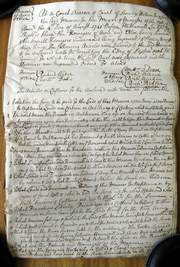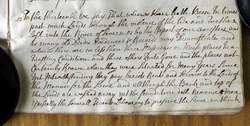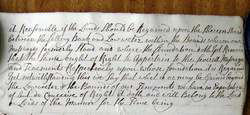Abandoned Communities ..... Woodend
The evidence that there were at least six dwellings at Woodend comes from a manorial court record that can be seen at Gloucestershire Archives. If you go to the Archives and ask for record number D3270/19718 a large box will be delivered to you that contains two parcels wrapped in brown paper. Select the parcel with records from 1723 to 1745. Inside the parcel you will find two bundles of documents. Inside the bundle covering 1734 to 1745 you will find the record of a court baron and court of survey for the Manor of Awre and Etloe convened on 4 August 1741.
If you are curious about the various types of manorial courts the Lancaster University website at this address can be recommended.
I will reproduce the relevant parts of the record on the left. It includes a long list of issues presented to the court and then the decisions made, after an adjournment until 2 September. The reference to Woodend comes in article 13, which refers to land between Brimspill and Awre. In essence the court was asked to determine whether land that might be regained from the Severn in future would belong to the lord of the manor or to the tenants.
The statement of the decision on article 13 mentions that much land had been “through the violence of the tide and weather lost to the River of Severn”. The evidence for this came from the “reports of our ancestors” and from “many old deeds, evidences and records”. Not less than three messuages (dwellings) were in a wasting condition, and three others “quite gone and the places not certainly known where they were situated”. The foundations, presumably of those messuages whose location was known, were still in existence. Indeed, their tenants were labouring to preserve them.
The decision, if I have understood it correctly, seems a fair one. Land regained within the boundaries of the plots where the dwellings had stood would be regarded as part of those plots, but if additional land beyond the low water mark or outside the boundaries of the “tenements” should be claimed then it would belong to the Lord of the Manor.
As it happens it has never been necessary to apply the decision. If anything, that part of the estuary shoreline has continued to suffer a net loss of sediment, and no further attempt has been made to build houses close to it. About 25 years ago the bank was reinforced with stone and rubble, but it is now most unlikely that further action of this kind will be taken. The Severn Estuary Shoreline Management Plan has determined that in Management Unit 11/1, within which lies the location of Woodend, the “Do Nothing” option is the preferred overall strategic option for the shorter term and for the longer term. Rising sea levels and more frequent winter storms over the coming decades will of course tend to confirm this decision.
If you are curious about the various types of manorial courts the Lancaster University website at this address can be recommended.
I will reproduce the relevant parts of the record on the left. It includes a long list of issues presented to the court and then the decisions made, after an adjournment until 2 September. The reference to Woodend comes in article 13, which refers to land between Brimspill and Awre. In essence the court was asked to determine whether land that might be regained from the Severn in future would belong to the lord of the manor or to the tenants.
The statement of the decision on article 13 mentions that much land had been “through the violence of the tide and weather lost to the River of Severn”. The evidence for this came from the “reports of our ancestors” and from “many old deeds, evidences and records”. Not less than three messuages (dwellings) were in a wasting condition, and three others “quite gone and the places not certainly known where they were situated”. The foundations, presumably of those messuages whose location was known, were still in existence. Indeed, their tenants were labouring to preserve them.
The decision, if I have understood it correctly, seems a fair one. Land regained within the boundaries of the plots where the dwellings had stood would be regarded as part of those plots, but if additional land beyond the low water mark or outside the boundaries of the “tenements” should be claimed then it would belong to the Lord of the Manor.
As it happens it has never been necessary to apply the decision. If anything, that part of the estuary shoreline has continued to suffer a net loss of sediment, and no further attempt has been made to build houses close to it. About 25 years ago the bank was reinforced with stone and rubble, but it is now most unlikely that further action of this kind will be taken. The Severn Estuary Shoreline Management Plan has determined that in Management Unit 11/1, within which lies the location of Woodend, the “Do Nothing” option is the preferred overall strategic option for the shorter term and for the longer term. Rising sea levels and more frequent winter storms over the coming decades will of course tend to confirm this decision.
Four
First page of the 1741 court record
The court’s decision


